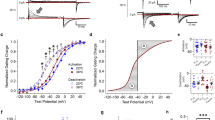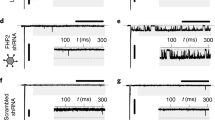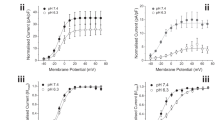Abstract
MinK is a widely expressed protein of relative molecular mass ∼15K that forms potassium channels by aggregation with other membrane proteins1,2,3. MinK governs ion channel activation4, regulation by second messengers5,6, and the function and structure of the ion conduction pathway7,8. Association of minK with a channel protein known as KvLQT1 produces a voltage-gated outward K+ current (IsK) resembling the slow cardiac repolarization current (IKs)9,10. HERG, a human homologue of the ether-a-go-go gene of the fruitfly Drosophila melanogaster, encodes a protein that produces the rapidly activating cardiac delayed rectifier (IKr)11,12. These two potassium currents, IKs and IKr, provide the principal repolarizing currents in cardiac myocytes for the termination of action potentials13,14. Although heterologously expressed HERG channels are largely indistinguishable from native cardiac IKr, a role for minK in this current is suggested by the diminished IKr in an atrial tumour line subjected to minK antisense suppression15. Here we show that HERG and minK form a stable complex, and that this heteromultimerization regulates IKr activity. MinK, through the formation of heteromeric channel complexes, is thus central to the control of the heart rate and rhythm.
This is a preview of subscription content, access via your institution
Access options
Subscribe to this journal
Receive 51 print issues and online access
$199.00 per year
only $3.90 per issue
Buy this article
- Purchase on Springer Link
- Instant access to full article PDF
Prices may be subject to local taxes which are calculated during checkout




Similar content being viewed by others
References
Blumenthal, E. M. & Kaczmarek, L. K. The minK potassium channel exists in functional and nonfunctional forms when expressed in the plasma membrane of Xenopus oocytes. J. Neurosci. 14, 3097–3105 (1994).
Wang, K.-W. & Goldstein, S. A. N. Subunit composition of minK potassium channels. Neuron 14, 1303–1309 (1995).
Tai, K. K., Wang, K. W. & Goldstein, S. A. N. MinK potassium channels are heteromultimeric complexes. J. Biol. Chem. 272, 1654–1658 ((1997)).
Takumi, T. et al. Alteration of channel activities and gating by mutations of slow IsKpotassium channel. J. Biol. Chem. 2266, 22192–22198 (1991).
Blumenthal, E. M. & Kaczmarek, L. Modulation by cAMP of a slowly activating potassium channel expressed in Xenopus oocytes. J. Neurosci. 12, 290–295 (1992).
Busch, A. E., Kavanaugh, M. P., Varnum, J. P. & Adelman, J. P. Regulation by second messengers of the slowly activating, voltage-dependent potassium current expressed in Xenopus oocytes. J. Physiol. 450, 491–502 (1992).
Goldstein, S. A. N. & Miller, C. Site-specific mutations in a minimal voltage-dependent K+ channel alter ion selectivity and open-channel block. Neuron 7, 403–408 (1991).
Wang, K. W., Tai, K. K. & Goldstein, S. A. N. MinK residues line a potassium channel pore. Neuron 16, 571–577 (1996).
Sanguinetti, M. C. et al. Coassembly of KVLQTl and minK (IsK) proteins to form cardiac IKspotassium channel. Nature 384, 80–83 (1996).
Barhanin, J. et al. KVLQT1 and IsK (minK) proteins associate to form IKscardiac potassium current. Nature 384, 80–83 (1996).
Sanguinetti, M. C., Jiang, C., Curran, M. E. & Keating, M. T. Amechanistic link between an inherited and an acquired cardiac arrhythmia: HERG encodes the IKrpotassium channel. Cell 81, 299–307 (1995).
Trudeau, M. C., Warmke, J. W., Ganetzky, B. & Robertson, G. A. HERG, a human inward rectifier in the voltage-gated potassium channel family. Science 269, 92–95 (1995).
Sanguinetti, M. C. & Jurkiewicz, N. K. Two components of the delayed rectifier K+current: differential sensitivity to block by class III antiarrhythmic agents. J. Gen. Physiol. 96, 195–215 (1990).
Sanguinetti, M. C. & Jurkiewicz, N. K. Delayed rectifier outward K+current is composed of two currents in guinea pig atria cells. Am. J. Physiol. 260, H393–H399 (1991).
Yang, T., Kupershmidt, S. & Roden, D. M. Anti-minK antisense decreases the amplitude of the rapidly activating cardiac delayed rectifier K+current. Circ. Res. 77, 1246–1253 (1995).
Lesage, F. et al. Are Xenopus oocytes unique in displaying functional IsK channel heterologous expression? Receptors and Channels 1, 143–152 (1993).
Margiotta, J. F., Berg, D. K. & Dionne, V. E. Cyclic AMP regulates the proportion of functional acetylcholine receptors on chicken cilliary ganglion neurons. Proc. Natl Acad. Sci. USA 84, 8155–8159 (1987).
Pardo, L. A. et al. Extracellular K+ specifically modulates a brain K+ channel. Proc. Natl Acad. Sci. USA 89, 2466–2470 (1992).
Brahmajothi, M. V. et al. In situ hybridization reveals extensive diversity of K+ channel mRNA in isolated ferret cardiac myocytes. Circ. Res. 78, 1083–1089 (1996).
Choy, A.-M. J., Kupershmidt, S., Lang, C. C., Pierson, R. N. & Roden, D. M. Regional expression of HERG and KVLQT1 in heart failure. Circulation 94, 1–I164 (1996).
Curran, M. E. et al. Amolecular basis for cardiac arrhythmia: HERG mutations cause long QT syndrome. Cell 80, 795–803 (1995).
Wang, Q. et al. Positional cloning of a novel potassium channel gene: KVLQT1 mutations cause cardiac arrhythmias. Nature Genet. 12, 17–25 (1996).
Roden, D. M. et al. Multiple mechanisms in the long-QT syndrome: Current knowledge, gaps, and future directions. Circ. Res. 94, 1996–2012 (1996).
Vetter, D. E. et al. Inner ear defects induced by null mutation of the isk gene. Neuron 17, 1251–1264 (1996).
Sugimoto, T. et al. Immunohistochemical study of a rat membrane protein which induces a selective potassium permeation: its localization in the apical membrane portion of epithelial cells. J. Membr. Biol. 113, 39–47 (1990).
. Sakagami, M. et al. Cellular localization of rat Isk protein in the stria vascularis by immunohistochemical observation. Hearing Res. 56, 168–172 (1991).
Freeman, L. C. & Kass, R. S. Expression of a minimal K+channel protein in mammalian cells and immunolocalization in guinea pig heart. Circ. Res. 73, 968–973 (1993).
Attali, B. et al. Cloning, functional expression, and regulation of two K+channels in human T lymphocytes. J. Biol. Chem. 267, 8650–8657 (1992).
Pond, A. L., Petrecca, K., Van Wagoner, D. R., Shrier, A. & Nerbonne, J. M. Distinct isoforms of ERG expressed in rat and human heart. Circ. Res. (submitted).
Smith, P. L., Baukrowitz, T. & Yellen, G. The inward rectification mechanism of the HERG cardiac potassium channel. Nature 379, 833–836 (1996).
Acknowledgements
We thank G. Robertson for HERG cDNA, J. Nerbonne and A. Pond for HERG antisera, K. Sawada for E4031, and V. S. Srinivas for technical assistance. This work was supported by funds from the AECOM Molecular Cardiology Endowment to T.V.M., M.B.M. and G.I.F., and by grants to G.I.F. from the American Heart Association (Established Investigator) and the Council for Tobacco Research and to S.A.N.G. from the NIH-NIGMS and Donaghue Foundation.
Author information
Authors and Affiliations
Corresponding author
Rights and permissions
About this article
Cite this article
McDonald, T., Yu, Z., Ming, Z. et al. A minK–HERG complex regulates the cardiac potassium current IKr. Nature 388, 289–292 (1997). https://doi.org/10.1038/40882
Received:
Accepted:
Issue Date:
DOI: https://doi.org/10.1038/40882
This article is cited by
-
Functional evaluation of gene mutations in Long QT Syndrome: strength of evidence from in vitro assays for deciphering variants of uncertain significance
Journal of Congenital Cardiology (2020)
-
Latent pathogenicity of the G38S polymorphism of KCNE1 K+ channel modulator
Heart and Vessels (2017)
-
Nonlinear Poisson autoregression
Annals of the Institute of Statistical Mathematics (2012)
-
KCNE1D85N polymorphism — a sex-specific modifier in type 1 long QT syndrome?
BMC Medical Genetics (2011)
Comments
By submitting a comment you agree to abide by our Terms and Community Guidelines. If you find something abusive or that does not comply with our terms or guidelines please flag it as inappropriate.



